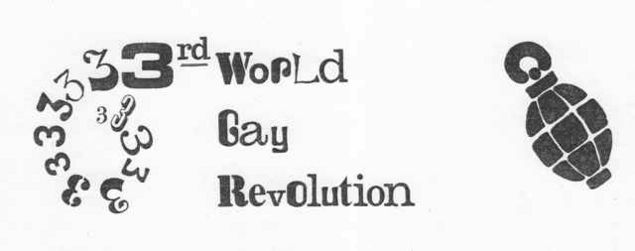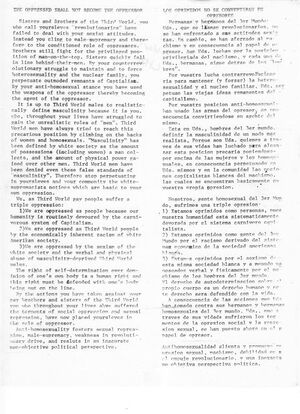Difference between revisions of "Third World Gay Revolution"
m (Protected "Third World Gay Revolution" [edit=sysop:move=sysop]) |
|||
| (30 intermediate revisions by one other user not shown) | |||
| Line 1: | Line 1: | ||
| − | + | ''This page focuses on the Third World Gay Revolution, a group organized in the summer of 1970 by Black and Latino members of the [[Gay Liberation Front]].'' | |
| − | + | [[Image:TWGR.jpg|thumb|center|635px|''Gay Flames Pamphlet'', no. 7. Courtesy of Lesbian Herstory Archives]] | |
| − | |||
| − | |||
| − | + | In July of 1970, a group of Black and Latino gays and lesbians split off from the [[Gay Liberation Front]] to form the Third World Gay Revolution. Arguing that they '''"suffer[ed] a triple oppression"''' by capitalism, racism, and sexism, TWGR members developed a broad political platform.<ref>“The Oppressed Shall Not Become the Oppressor,” Gay Liberation Front (GLF) N.Y. Organizational File, Lesbian Herstory Archives, Brooklyn, NY.</ref> In a statement modeled on the Black Panther Party's [http://www.blackpanther.org/TenPoint.htm Ten Point Program], the group demanded—among other things—'''"self-determination for all third world and gay people"'''; '''"liberation for women"'''; '''"a free educational system that teaches us our true identity and history"'''; '''"full employment for third world and gay people"'''; '''"decent housing"'''; and''' "an immediate end to police brutality and murder of third world and gay people."'''<ref>"3rd World Gay Revolution Platform," ''Gay Flames'', no. 7. Partially reprinted in Donn Teal, ''The Gay Militant''s (New York: Stein and Day Publishers, 1971), 213-14.</ref> | |
| − | + | Members of TWGR also challenged the discrimination they faced in gay liberation and "third world” movements.<ref>Néstor Latrónico, “My Memories as a Gay Militant in NYC,” in ''Smash the Church, Smash the State'', ed. Tommi Avicolli Mecca (San Francisco: City Lights Books, 2009), 51.</ref>[[Image:TWGR Flier 2.jpg|thumb|left|"The Oppressed Shall Not Become the Oppressor." A statement criticizing anti-gay attitudes in "Third World" communities, published in both English and Spanish. Courtesy of the Lesbian Herstory Archives.]] GLFers worked hard to confront their own racism—and the group made antiracist politics an integral part of its platform, devoting significant time and resources to support organizations like the [http://www.blackpanther.org/legacynew.htm Black Panther Party] (BPP) and the [http://palante.org/AboutYoungLords.htm Young Lords Party] (YLP).<ref>Ibid.</ref> | |
| + | |||
| + | Nonetheless, in introducing their group to the readers of [[Come Out!]], TWGR members explained: | ||
| + | |||
| + | '''"Third world gays suffer an oppression which is not shared by our white sisters and brothers, one which they could never really FEEL. Therefore, despite the many organizations emerging in the Gay Liberation movement, third world people haven’t been able to relate to any of these. This is due to the inherent racism found in any white group with white leadership and white thinking."'''<ref>“T.W.G.R. Third World Gay Revolution,” ''Come Out!'' 1, no. 5 (September/October, 1970): 12. Emphasis in original.</ref> | ||
| + | |||
| + | TWGR organized [[Consciousness-Raising]] groups that provided a space for gay people of color to explore their oppression and come together around their particular struggles.<ref>Ibid.</ref> [[Image:TWGR 2.jpg|thumb|right|''Gay Flames Pamphlet'', no. 7. Courtesy of the Lesbian Herstory Archives.]]The group also urged white gay liberationists to confront their '''"collegiate and middle-class viewpoint"''' and challenged the '''"verbal and physical abuse"''' they had endured from '''"masculinity-deprived Third World males."'''<ref>“Gay People Help Plan New World,” Gay Flames Pamphlet, no. 2. Reprinted in Teal, ''Gay Militants'', 173; "The Oppressed Shall Not Become the Oppressor."</ref> | ||
| + | |||
| + | Despite its criticisms, TWGR maintained ties with both gay liberation and “third world” movements. In the fall of 1970, the group helped to lead the gay delegation at the BPP-sponsored Revolutionary People’s Constitutional Convention.<ref>Teal, ''Gay Militants'', 212-9; Lois Hart, “Black Panthers Call a Revolutionary People’s Constitutional Convention: A White Lesbian Responds,” ''Come Out!'' 1, no. 5 (September/October 1970): 15.</ref> Members also proudly carried “gay banners” at actions for the Black Panthers and the Young Lords, and at least one gay liberationist saw them as the '''"real connection to the struggle to transform the Black Liberation movement."'''<ref>Latrónico, “My Memories as a Gay Militant in NYC,” 51; Hart, "Black Panthers Call A Revolutionary People's Constitutional Convention," 15.</ref> | ||
| + | |||
| + | Although TWGR collapsed after only a few months, the group highlighted the ways racism and homophobia simultaneously affect the lives of gay people of color, helping to spark new movements that continue to this day. | ||
| − | |||
Return to [[Gay Liberation in New York City]]. | Return to [[Gay Liberation in New York City]]. | ||
| + | |||
| + | ===Categories=== | ||
| + | Gay Liberation, | ||
| + | New York City, | ||
| + | Gay Liberation Front, | ||
| + | Third World Gay Revolution, | ||
| + | Racism | ||
| + | |||
| + | ===Contact=== | ||
| + | Lindsay Branson: lindsay.branson@gmail.com | ||
==References== | ==References== | ||
<references/> | <references/> | ||
Latest revision as of 10:42, 1 May 2010
This page focuses on the Third World Gay Revolution, a group organized in the summer of 1970 by Black and Latino members of the Gay Liberation Front.
In July of 1970, a group of Black and Latino gays and lesbians split off from the Gay Liberation Front to form the Third World Gay Revolution. Arguing that they "suffer[ed] a triple oppression" by capitalism, racism, and sexism, TWGR members developed a broad political platform.[1] In a statement modeled on the Black Panther Party's Ten Point Program, the group demanded—among other things—"self-determination for all third world and gay people"; "liberation for women"; "a free educational system that teaches us our true identity and history"; "full employment for third world and gay people"; "decent housing"; and "an immediate end to police brutality and murder of third world and gay people."[2]
Members of TWGR also challenged the discrimination they faced in gay liberation and "third world” movements.[3]
GLFers worked hard to confront their own racism—and the group made antiracist politics an integral part of its platform, devoting significant time and resources to support organizations like the Black Panther Party (BPP) and the Young Lords Party (YLP).[4]
Nonetheless, in introducing their group to the readers of Come Out!, TWGR members explained:
"Third world gays suffer an oppression which is not shared by our white sisters and brothers, one which they could never really FEEL. Therefore, despite the many organizations emerging in the Gay Liberation movement, third world people haven’t been able to relate to any of these. This is due to the inherent racism found in any white group with white leadership and white thinking."[5]
TWGR organized Consciousness-Raising groups that provided a space for gay people of color to explore their oppression and come together around their particular struggles.[6]
The group also urged white gay liberationists to confront their "collegiate and middle-class viewpoint" and challenged the "verbal and physical abuse" they had endured from "masculinity-deprived Third World males."[7]
Despite its criticisms, TWGR maintained ties with both gay liberation and “third world” movements. In the fall of 1970, the group helped to lead the gay delegation at the BPP-sponsored Revolutionary People’s Constitutional Convention.[8] Members also proudly carried “gay banners” at actions for the Black Panthers and the Young Lords, and at least one gay liberationist saw them as the "real connection to the struggle to transform the Black Liberation movement."[9]
Although TWGR collapsed after only a few months, the group highlighted the ways racism and homophobia simultaneously affect the lives of gay people of color, helping to spark new movements that continue to this day.
Return to Gay Liberation in New York City.
Categories
Gay Liberation, New York City, Gay Liberation Front, Third World Gay Revolution, Racism
Contact
Lindsay Branson: lindsay.branson@gmail.com
References
- ↑ “The Oppressed Shall Not Become the Oppressor,” Gay Liberation Front (GLF) N.Y. Organizational File, Lesbian Herstory Archives, Brooklyn, NY.
- ↑ "3rd World Gay Revolution Platform," Gay Flames, no. 7. Partially reprinted in Donn Teal, The Gay Militants (New York: Stein and Day Publishers, 1971), 213-14.
- ↑ Néstor Latrónico, “My Memories as a Gay Militant in NYC,” in Smash the Church, Smash the State, ed. Tommi Avicolli Mecca (San Francisco: City Lights Books, 2009), 51.
- ↑ Ibid.
- ↑ “T.W.G.R. Third World Gay Revolution,” Come Out! 1, no. 5 (September/October, 1970): 12. Emphasis in original.
- ↑ Ibid.
- ↑ “Gay People Help Plan New World,” Gay Flames Pamphlet, no. 2. Reprinted in Teal, Gay Militants, 173; "The Oppressed Shall Not Become the Oppressor."
- ↑ Teal, Gay Militants, 212-9; Lois Hart, “Black Panthers Call a Revolutionary People’s Constitutional Convention: A White Lesbian Responds,” Come Out! 1, no. 5 (September/October 1970): 15.
- ↑ Latrónico, “My Memories as a Gay Militant in NYC,” 51; Hart, "Black Panthers Call A Revolutionary People's Constitutional Convention," 15.


